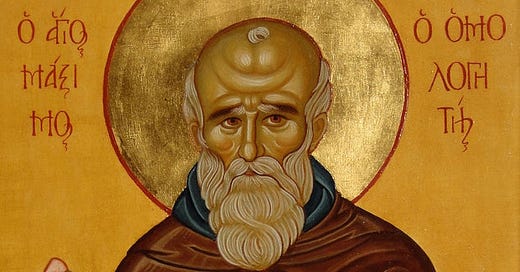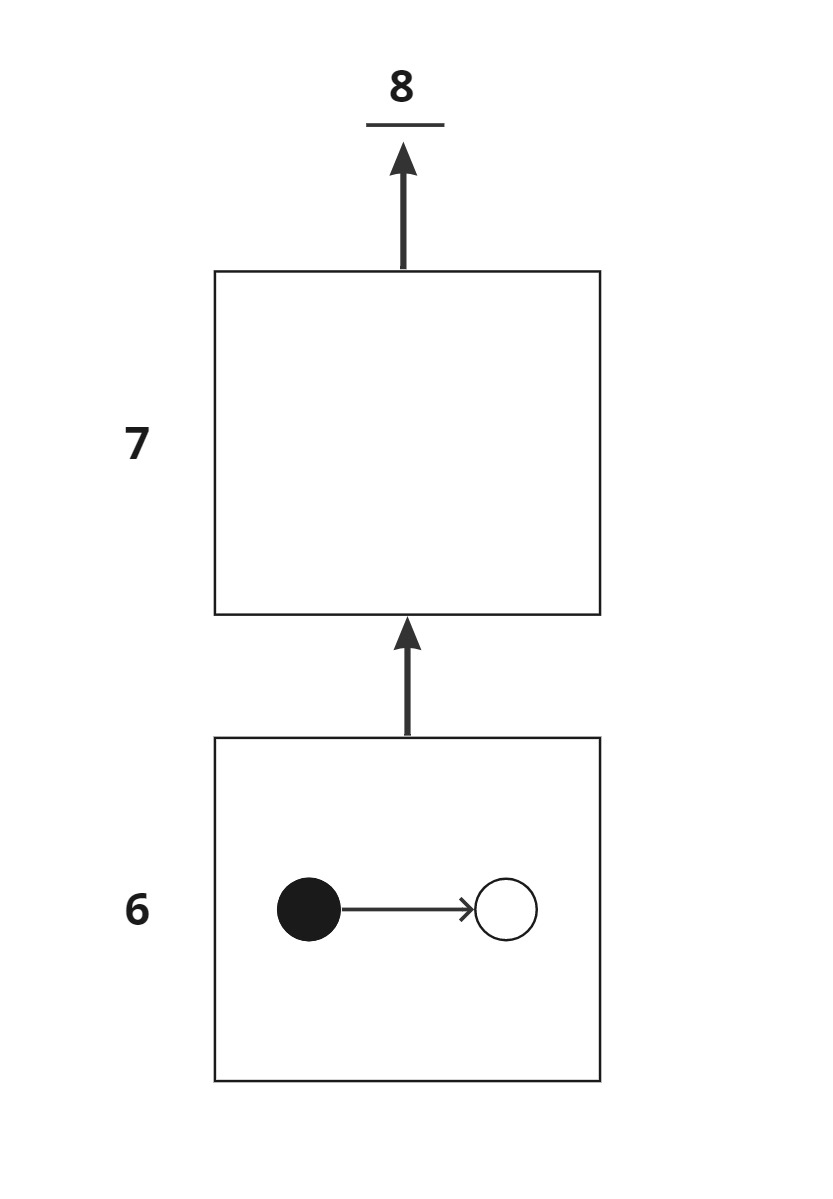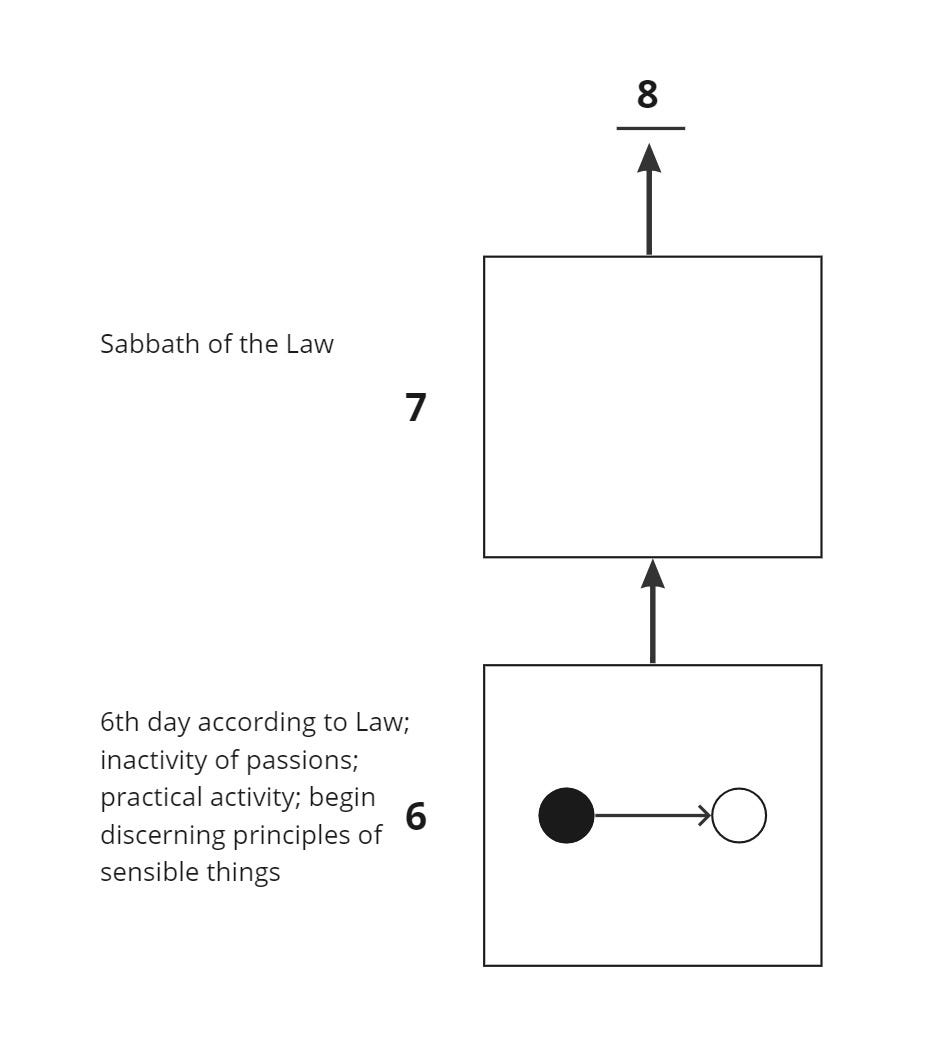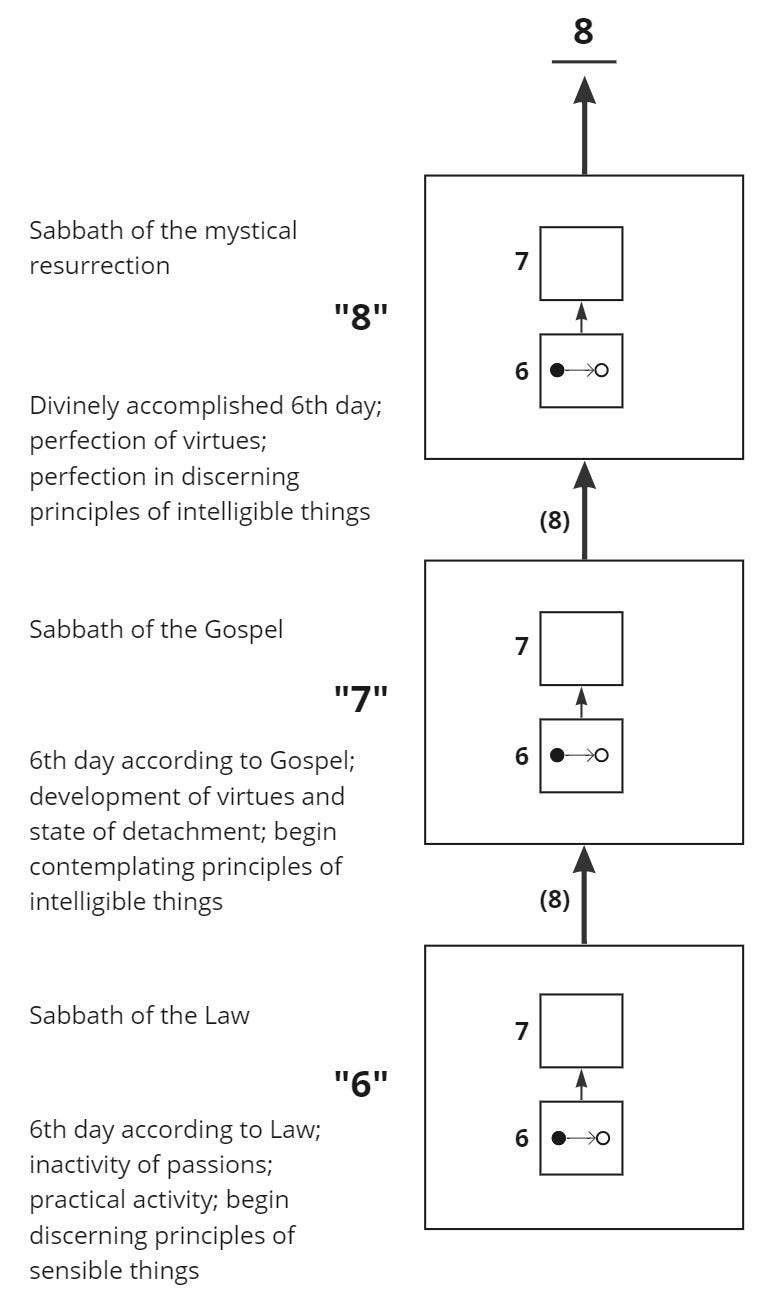In my last article, I began to examine how the pattern purification, illumination, and perfection shows up in diverse and interesting ways in Gospel symbolism. I paid special attention to the Three Marys depicted at the Crucifixion in the Gospel of John, using them as a key to unlocking the same pattern elsewhere. I’d now like to explore that pattern in further depth and uncover a few other major instances, which as you’ll see are related to each other hierarchically in what I’ll call the “6 - 7 - 8 fractal.” I’ll stick with the Gospel of John here again, since it’s arranged in such a way as to really highlight this fractal structure. But first I’ll need to provide a fairly extensive detour through some crucial insights from Maximus the Confessor. So this article will have to be in several parts (I’m not sure yet how many), with said detour as the introduction.
6 - 7 - 8 according to St. Maximus
In his Chapters on Knowledge, St. Maximus lays out a wonderful set of tools for understanding purification, illumination, and perfection. As I showed in my Three Marys article, he associates this triad with the sixth, seventh, and eighth days of creation and in doing so relates the stages of the individual’s movement toward God with the same progression occurring at the level of the whole cosmos.
According to St. Maximus:
The sixth day is both the “completion of beings subject to nature” and the “state of inactivity of the passions” whereby one “comes into the inheritance of the virtues.”1
The seventh day is both “the full return to [God] of all creatures whereby he rests from his own natural activity toward them, his very divine activity”2 and “the fulfillment and rest of the natural activities of those who contemplate the ineffable knowledge.”3
The eighth day is both the eschatological “hour of fulfillment” for the entire cosmos and the “transition to deification of those who are worthy.”4
So here we have the 6 - 7 - 8 progression for both microcosm and macrocosm. It’s important to note that for St. Maximus these aren’t rigid or absolutely fixed categories. Yes, they constitute a definite threefold pattern, but the way each stage can be described is malleable; the same words and relationships can mean different things in different contexts. This is because, as my friend Cormac Jones has pointed out in a fantastic recent article, the pattern is fractal. “Each stage contains the others. You don’t exhaust the need for purification before you already need a form of illumination,” says Cormac.5 St. Maximus hints at the fractality of the 6 - 7 - 8 pattern by indicating that the stages themselves are staged. There is a basic sixth day which gives way to a more advanced one, and another more advanced one after that. These three stages of sixth day in turn correspond to three increasingly exalted seventh days, or Sabbaths. When it comes to the eighth day, it no longer really makes sense to think about dividing into discernible stages, since what we’re dealing with here is union with the Infinite. One moves beyond progression to ultimate attainment. For understanding this, St. Maximus provides us with his notion of “ever-moving fixity,”6 which, though ineffable, we can perhaps from our limited perspective think of as a residing within continual upward movement, or an ever-deepening reciprocal offering of love.
Visualizing the fractal structure
Since the 6 - 7 - 8 pattern is fractal, it admits – at least to a degree – of an overall nested structure that can be visually depicted. Let’s take a look at one way this might be done. First, we’ll start with the basic fractal kernel, or fundamental structure to be iterated. It looks something like this:
In the box represented by the sixth day, I’ve included two circles with a connecting arrow to indicate the inherent movement associated with this day. The sixth day, when considered in connection with purification, is a cleansing, a movement from a lower to a higher state. For instance, from raging passions to passions quelled. Hence the black circle moving toward the white circle.
Moving upward to the seventh day, you’ll notice that there are no circles at this stage. That’s because the seventh day is a kind of opening or portal, an exchange – as you might recall from my previous article – affecting a transformation both within the level below it and between the lower level and the higher level. The Sabbath both concludes the purification of the sixth day and lifts it up toward the eighth. It itself isn’t the thing that’s changing but rather the facilitator of the change. So, no circles in 7’s box.
Given its special importance, I’ve chosen not to represent the mystical eighth day (in the basic kernel at least) with a box. Really the eighth day isn’t something that can be visually contained, and so I’m depicting it here as simply an arrow pointed up toward a limit (the horizontal line).
Now that we have our basic kernel, we can begin adding some detail to see the fractal start coming together. In describing the first or basic level of sixth day, St. Maximus says,
“The one who spends the sixth day solely according to the Law in fleeing the tyranny of the passions which strongly oppress the soul fearlessly crosses the sea toward the desert; he observes the Sabbath only by the inactivity of the passions.”7
So here we see the sixth day associated with the practical activity of battling the passions and the Sabbath as its culmination and rest. The Sabbath always points to the eighth day, but here we are made aware that there are further stages to come before the hour of fulfillment is at hand. To see this we need to move up a level in our schema.
In reference to moving toward the second level of sixth day, St. Maximus uses the symbol of “crossing the Jordan.” Picking up from the end of the previous quote, he writes:
“But the one who crosses the Jordan, having gone even beyond the simple state of inactivity of the passions, comes to the inheritance of the virtues.
The one who spends the sixth day according to the Gospel, having already given up the first movements of sin, acquires by his virtues the state of detachment which is removed from all evil; he makes Sabbath in his mind of the simple representation of the passions.”8
St. Maximus is telling us that after one has passed the basic stage of quieting the passions, one then moves onto developing the virtues. This in turn leads to perfection in discerning the principles of sensible things and opens one up to the contemplation of intelligible things.9 Notice now the fractal structure beginning to emerge, where it’s possible to see the relationship between the entire first and second stages as themselves a 6 - 7 relationship. Following the pattern, we cross the Jordan a second time and arrive at a yet higher level:
“The one who has crossed over the Jordan is transported to the region of knowledge where the mind, mystically built by peace as a temple, becomes the dwelling-place of God in the Spirit.
The one who has divinely accomplished in himself the sixth day by appropriate works and thoughts, and who has with God nobly brought his works to an end, has crossed by comprehension all the ground of what is subject to nature and time. He is transported to the mystical contemplation of the immortal ages, and in an unknowable manner he makes Sabbath in his mind in leaving behind and totally surpassing beings.”10
And with this final upward crossing the 6 - 7 - 8 fractal comes into full view. Each level of 6 - 7 - 8 is itself part of a larger 6 - 7 - 8 pattern. We see here that, even in the highest stage where discernment of intelligible things reaches its apex and one crosses beyond the threshold of all creaturely limitation, there is still a movement upward. How should we reckon with this? If the eighth day is supposed to be the “hour of fulfillment” beyond nature and time, why is the temporally-limited motion and becoming of purification and illumination still at work? The answer is that the eighth day both contains the seventh and sixth days within itself and transcends them. The union of God and man in Christ lifts creation up all the way from the very bottom and perfectly joins it to God, who himself is all in all while simultaneously above all. St. Maximus hints at this transcendence of the eighth day attainment in the quote above, saying it occurs “in an unknowable manner.” “The eighth [day],” he says, “communicates the ineffable mystery of the eternal well-being of things.”11
That’s probably enough for now. It’s my habit toward the end of writing a piece to spend long hours concocting a pithy and poignant ending. But in the effort to accustom myself to the ongoing-conversational Substack format (it might not look like it, but this is me trying!), I think I’ll do without that here. Let me lastly just take another opportunity to remind the reader that, although my manner of presentation above is admittedly rather technical, the schema I’m gleaning from St. Maximus (which is, I should add, only my interpretation) isn’t a fixed or rigid system but is intended to be a tool for bringing certain patterns into view. It’s fractal, after all, and so by definition it will elude any attempt to freeze-frame it. Additionally, once we start to apply the tool to actual Gospel narratives, a good amount of the dry technicality that comes with presenting a pattern in the abstract will fall away.
Now that we’ve got the 6 - 7 - 8 fractal in place, we can move on in part 2 to seeing it play out in the Gospel of John.
Maximus the Confessor. “Chapters on Knowledge,” in “Maximus Confessor, Selected Writings,” Trans. George C. Berthold, p.137. Paulist Press, 1985.
Ibid., 136.
Ibid., 138.
Ibid., 138.
Jones, Cormac. “Art as food; on the preparation and consumption thereof.” The Cormac Jones Journal, February 2023.
This is at least the translation given in: Loudovikos, Nikolaos. “A Eucharistic Ontology: Maximus the Confessor’s Eschatological Ontology of Being as Dialogical Reciprocity,” p.179. Holy Cross Orthodox Press, 2010.
Maximus, Chapters, at 137.
Ibid., 137.
See ibid., 134-138.
Ibid., 137-138.
Ibid., 138, italics added.








Great job! I'm looking forward to seeing how you apply this to John.